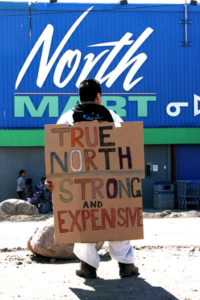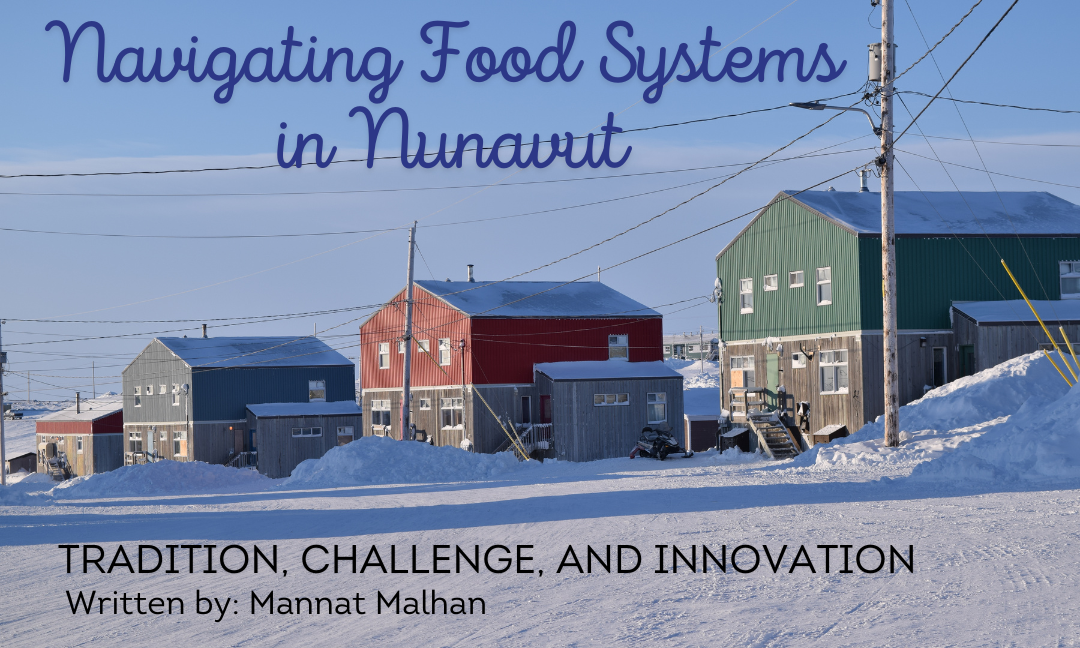Written by: Mannat Malhan
Edited by: Rayna Almas
Designed by: Eshika Hiremath
Published by: Rayna Almas
Welcome to Nunavut, Canada’s northernmost territory, where the Arctic shapes not only the landscape, but the food culture here, too! Food systems in Nunavut are complex, shaped by the combination of traditional hunting practices and modern challenges like high food costs and climate change. In this article, we’ll explore the dynamics of food systems in Nunavut, from the importance of traditional hunting and fishing practices to the innovative solutions people have developed to address food security. Let’s take a bite out of what makes food in this northern paradise so special.
In Nunavut, there’s something called “country food”. This refers to traditionally sourced foods such as caribou, seal, whale, and Arctic char. Foods like these are deeply embedded in the history of the Inuit people. For example, seal hunting is a practice that involves the entire community, from the hunt to the preserving. The members gather in small groups and head out on the ice flows to find the seals. They use a combination of traditional knowledge and modern technologies such as snowmobiles to locate the seals. Caribou hunting requires knowing the migration patterns of the animal. Arctic char, another vital food source, is often preserved by smoking or drying.
 But beyond the processes, country food plays a crucial role in maintaining cultural identity. For the Inuit, hunting and fishing are at the core of their culture. They are part of a larger tradition that includes many social and cultural practices. They believe that the animals they gather are gifts from the land and that their lives are closely linked to the Earth. The knowledge of traditional foods and their preparation are often passed on by storytelling, teaching the younger generations about their heritage.
But beyond the processes, country food plays a crucial role in maintaining cultural identity. For the Inuit, hunting and fishing are at the core of their culture. They are part of a larger tradition that includes many social and cultural practices. They believe that the animals they gather are gifts from the land and that their lives are closely linked to the Earth. The knowledge of traditional foods and their preparation are often passed on by storytelling, teaching the younger generations about their heritage.
However, Nunavut faces significant challenges when it comes to food security. A 2016 report by Food Secure Canada showed that nearly 70% of Inuit households were food insecure, which was the highest rate of food insecurity in any Canadian province or territory. Some of the factors contributing to this crisis are:
- Climate change: The Arctic is warming at nearly three times the global rate, disrupting fishing and hunting practices. Due to this, sea-ice deterioration and changes in permafrost are expected to put communities in the North at risk. Current Arctic species are seeing changes in their natural habitats, such as new plants, reduced ice cover, changing ocean salinity, increased acidity, and changing snow patterns. Thinning ice makes it dangerous to hunt seals and the shifting migration patterns of caribou makes it even more unpredictable.
- High-cost of Store-Bought Food: Due to Nunavut’s remote location, most goods are transported by ship or plane, which results in excessive prices. A study done in 2017 showed that a healthy diet in Nunavut costs three times more than it does in southern Canada. For example, a single watermelon can cost as much as $50. Somebody on Tiktok spoke up about how a gallon of water was $34.99, and that was without tax! As a result, these prices put nutritious food out of reach for many families, making them rely on cheaper, less healthy alternatives.
- Limited Availability of Fresh Produce: The harsh climate and short growing season in Nunavut makes it difficult to grow fresh fruits and vegetables locally. This means that fresh produce is often scarce and of lower quality.
Despite these challenges, there are several initiatives aimed at improving food security. One of them is greenhouse projects. To fight the scarcity of fresh produce, communities like Inuvik and Iqaluit have established greenhouses. The Iqaluit Community Greenhouse gives a space for people to grow their own vegetables. This project not only gives fresh, affordable produce, but also plays a role as an educational hub for sustainable agriculture. Meaning, volunteers can learn more about farming and how they can help find solutions for food security.
Another initiative aimed at helping Nunavut is Nutrition North Canada, a government program that aims to address the issue of food insecurity and high food prices in remote and rural communities. The program was established in 2011 and provides a 50% subsidy on the cost of food items and other necessities that are shipped from southern Canada. While the program has been successful in reducing retail prices, it also has its limitations, such as the high transportation costs and the limited selection of food products available. To improve the program, Nutrition North Canada has implemented some measures, such as working with community leaders and local retailers to develop more efficient and cost-effective distribution models, and investing in storage facilities and transportation infrastructure. Even with all these efforts, there is still much more that needs to be done to ensure that all communities have access to affordable food.
 Along with this, food education and advocacy is also important. Organizations like The Nunavut Food Security Coalition, a non-profit organization dedicated to addressing food insecurity. Its mission is to work with community members, organizations, and government agencies to improve food policy, support community-led food initiatives, and develop a network of food banks and food kitchens. One of the main challenges faced by the coalition is the high cost of transportation, which makes it difficult to get fresh food to communities far north. Another issue is the limited availability of healthy food in some communities and the limited selection of food items available through the Nutrition North program, mentioned above. The coalition has given a number of solutions, including investing in transportation and storage infrastructure while advocating for greater government support.
Along with this, food education and advocacy is also important. Organizations like The Nunavut Food Security Coalition, a non-profit organization dedicated to addressing food insecurity. Its mission is to work with community members, organizations, and government agencies to improve food policy, support community-led food initiatives, and develop a network of food banks and food kitchens. One of the main challenges faced by the coalition is the high cost of transportation, which makes it difficult to get fresh food to communities far north. Another issue is the limited availability of healthy food in some communities and the limited selection of food items available through the Nutrition North program, mentioned above. The coalition has given a number of solutions, including investing in transportation and storage infrastructure while advocating for greater government support.
By and large, we’ve learned more about how unique Nunavut is. The landscape may be harsh, but the people are resilient. The region faces many challenges, including food security issues and severe environments. Traditional methods of hunting, fishing, and foraging have been essential for generations, but with the threat of climate change and high food prices, new solutions are needed to ensure that everyone has access to nutritious food. The community of Nunavut has demonstrated incredible perseverance in the face of these problems, and their efforts to address food security and protect traditional practices should inspire us all. By taking action and supporting their initiatives, we too can make a difference in the lives of others.
Bibliography
Works Cited
“Welcome to Nunavut Food Security Coalition | Nunavut Food Security Coalition.” Www.nunavutfoodsecurity.ca, www.nunavutfoodsecurity.ca/.
Natural Resources Canada. “Climate Change Adaptation in Canada.” Natural-Resources.canada.ca, Government of Canada, 17 May 2023, natural-resources.canada.ca/climate-change/what-adaptation/10025.
“Climate Change in Nunavut | Nunavut Climate Change Centre.” Climate Change Nunavut.ca, 2017, climatechangenunavut.ca/en/understanding-climate-change/climate-change-nunavut#:~:text=Overall%2C%20the%20number%20of%20 species. Accessed 6 Aug. 2024.
“Grocers Fail to Pass along Full Nutrition North Food Subsidy to Shoppers, Study Shows | University of Toronto Mississauga.” University of Toronto Mississauga, 14 Sep. 2023, www.utm.utoronto.ca/main-news/grocers-fail-pass-along-full-nutrition-north-food-subsidy-shoppers-study-shows#:~:text=Nutrition%20North%20was%20 intended%20to. Accessed 6 Aug. 2024.
Canada, Government of Canada; Crown-Indigenous Relations and Northern Affairs. “Nutrition North Canada.” Www.rcsnc-Carnac.gc.ca, 15 Dec. 2019, www.rcaanc-cirnac.gc.ca/eng/1576437858843/1576437881780.
Kira Wronska Dorward. “Iqaluit Greenhouse Program Teaches Youth about Solutions to Food Security.” Nunavut News, Nunavut News, Aug. 2024, www.nunavutnews.com/home/iqaluit-greenhouse-program-teaches-youth-about-solutions-to-food-security-7451104. Accessed 6 Aug. 2024.
“Rates | Nunavut Food Security Coalition.” Www.nunavut food security.ca, www.nunavutfoodsecurity.ca/Rates. Accessed 6 Aug. 2024.
Freeman, Minnie Aodla. “Inuit.” The Canadian Encyclopedia, 8 June 2010, www.thecanadianencyclopedia.ca/en/article/inuit.
Robinson, Amanda. “Country Food (Inuit Food) in Canada | the Canadian Encyclopedia.” The Canadian Encyclopedia, 19 July 2018, www.thecanadianencyclopedia.ca/en/article/country-food-inuit-food-in-canada.
News, Nunatsiaq. “Nunavut Has Highest Rate of Inadequate, Unaffordable Housing: Report.” Nunatsiaq News, 16 Dec. 2022, nunatsiaq.com/stories/article/nunavut-has-highest-rate-of-inadequate-unaffordable-housing-report/.
News, Nunatsiaq. “Nutrition North Gets Three New Inuit Board Members.” Nunatsiaq News, 15 July 2021, nunatsiaq.com/stories/article/nutrition-north-gets-three-new-inuit-board-members/. Accessed 7 Aug. 2024.
“Innuitian Mountains | Mountains, Nunavut, Canada.” Encyclopedia Britannica, www.britannica.com/place/Innuitian-Mountains. Accessed 7 Aug. 2024.

